The crisp morning air carries the earthy scent of fallen leaves as your boots crunch along the forest floor, each step revealing nature’s most spectacular annual transformation. Fall foliage hikes offer an unparalleled sensory experience that combines the physical benefits of outdoor exercise with the visual feast of autumn’s vibrant display. From the fiery maples of New England to the golden aspens of the Rocky Mountains, America’s autumn hiking trails provide some of the world’s most breathtaking seasonal spectacles.
According to the National Park Service, fall foliage viewing generates over $30 billion annually in tourism revenue across the United States, with hiking being the most popular way to experience these natural wonders. The science behind this phenomenon is equally fascinating—as daylight hours shorten and temperatures drop, trees cease chlorophyll production, revealing the hidden pigments that create those stunning reds, oranges, and yellows that define fall colors hiking experiences. This biological process, combined with specific geographic and climatic conditions, creates peak viewing windows that vary dramatically across regions, making timing crucial for seasonal hiking enthusiasts.
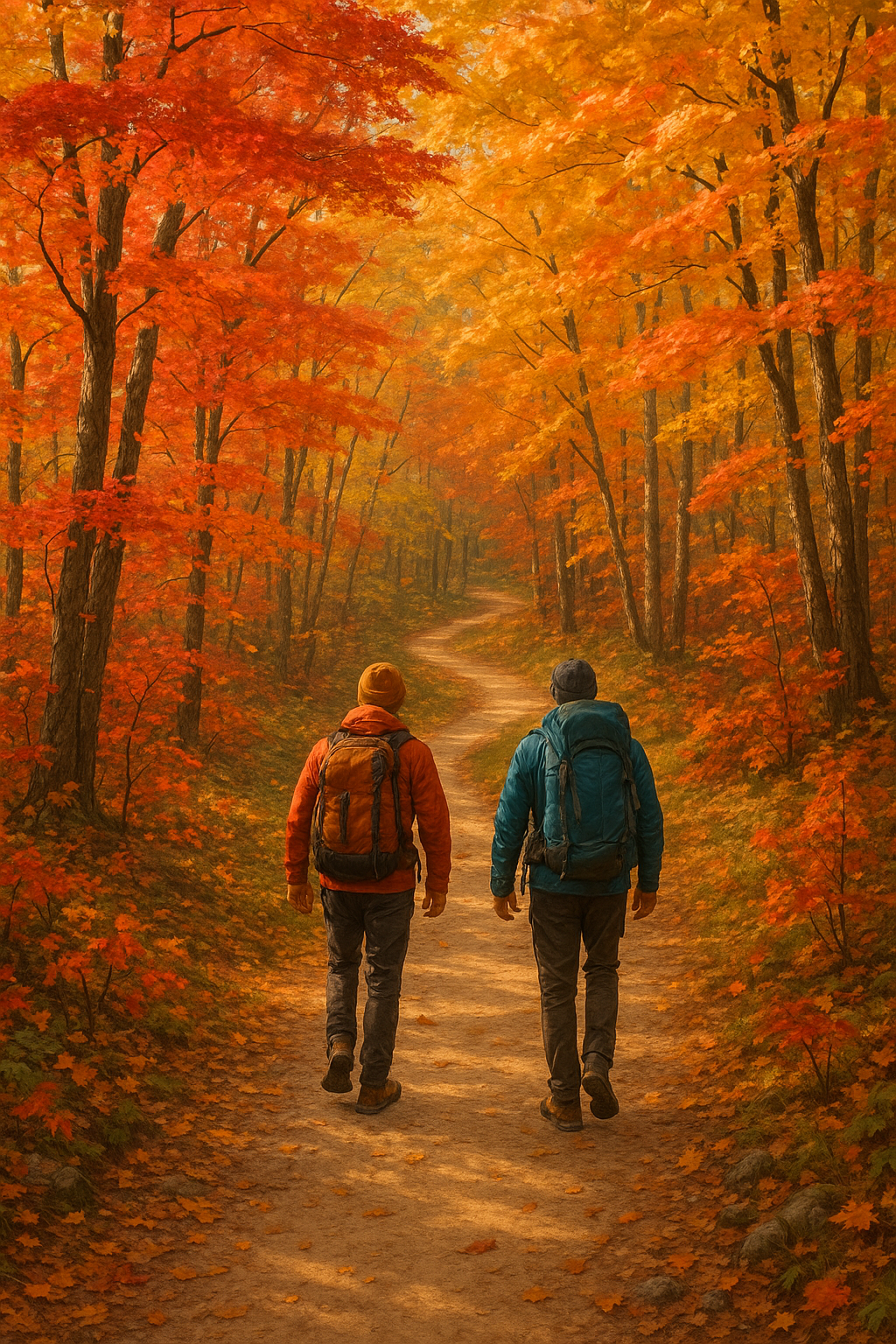
Whether you’re a seasoned backpacker seeking challenging mountain ascents or a family looking for gentle nature walks, this comprehensive guide reveals the best fall hiking destinations across America. From coastal Maine’s unique blend of ocean views and autumn colors to Colorado’s high-altitude aspen groves, each destination offers distinct characteristics that make autumn outdoor adventures unforgettable. We’ll explore twelve premier locations, provide detailed timing guides, share essential gear recommendations, and offer insider tips to help you plan the perfect fall foliage viewing expedition that captures nature’s fleeting masterpiece at its absolute peak.
Table of Contents
•Why Fall Foliage Hiking is America’s Premier Autumn Activity
•Best Time to Plan Your Fall Foliage Hiking Adventure
•Essential Gear for Autumn Trail Adventures
•Top 12 Fall Foliage Hiking Destinations
•Regional Fall Foliage Timing Guide
•Photography Tips for Capturing Autumn Colors
•Safety Considerations for Fall Hiking
•Planning Your Multi-Destination Fall Foliage Road Trip
Why Fall Foliage Hiking is America’s Premier Autumn Activity {#why-fall-foliage-hiking}
The allure of fall foliage hikes extends far beyond simple sightseeing, representing a perfect convergence of physical activity, mental wellness, and natural beauty that makes autumn hiking uniquely rewarding. Research published in the Journal of Environmental Psychology demonstrates that exposure to natural environments during peak color seasons significantly reduces cortisol levels and improves mood regulation more effectively than other seasonal outdoor activities. The combination of moderate physical exercise with the visual stimulation of vibrant autumn colors creates what researchers term “restorative experiences” that provide lasting mental health benefits.
From a physiological perspective, autumn hiking trails offer ideal conditions for extended outdoor exercise. The cooler temperatures of fall reduce heat stress and dehydration risks while maintaining comfortable conditions for sustained physical activity. Average temperatures during peak foliage season typically range from 45-65°F, creating optimal conditions for cardiovascular exercise without the extreme heat of summer or the harsh conditions of winter. This temperature range allows hikers to maintain steady exertion levels while enjoying extended periods outdoors, making fall colors hiking accessible to a broader range of fitness levels.
The economic impact of fall foliage viewing reflects its status as America’s premier autumn activity. The U.S. Forest Service reports that autumn recreation generates approximately $8 billion in direct spending annually, with hiking representing 60% of all fall outdoor activities. States like Vermont, New Hampshire, and Maine see tourism increases of 300-400% during peak foliage weeks, with best fall hiking destinations experiencing visitor numbers that rival major national parks during summer months. This economic significance has led to improved trail maintenance, enhanced visitor facilities, and expanded access to previously remote autumn outdoor adventures.
The scientific phenomenon underlying fall foliage creates a natural urgency that enhances the hiking experience. Unlike summer wildflowers or spring blooms that may last for months, peak autumn colors typically persist for only 2-3 weeks in any given location. This temporal limitation transforms seasonal hiking into a time-sensitive adventure that requires planning, preparation, and often spontaneous decision-making based on real-time foliage reports. The ephemeral nature of peak colors adds an element of excitement and exclusivity to fall foliage hikes that distinguishes them from other outdoor activities.
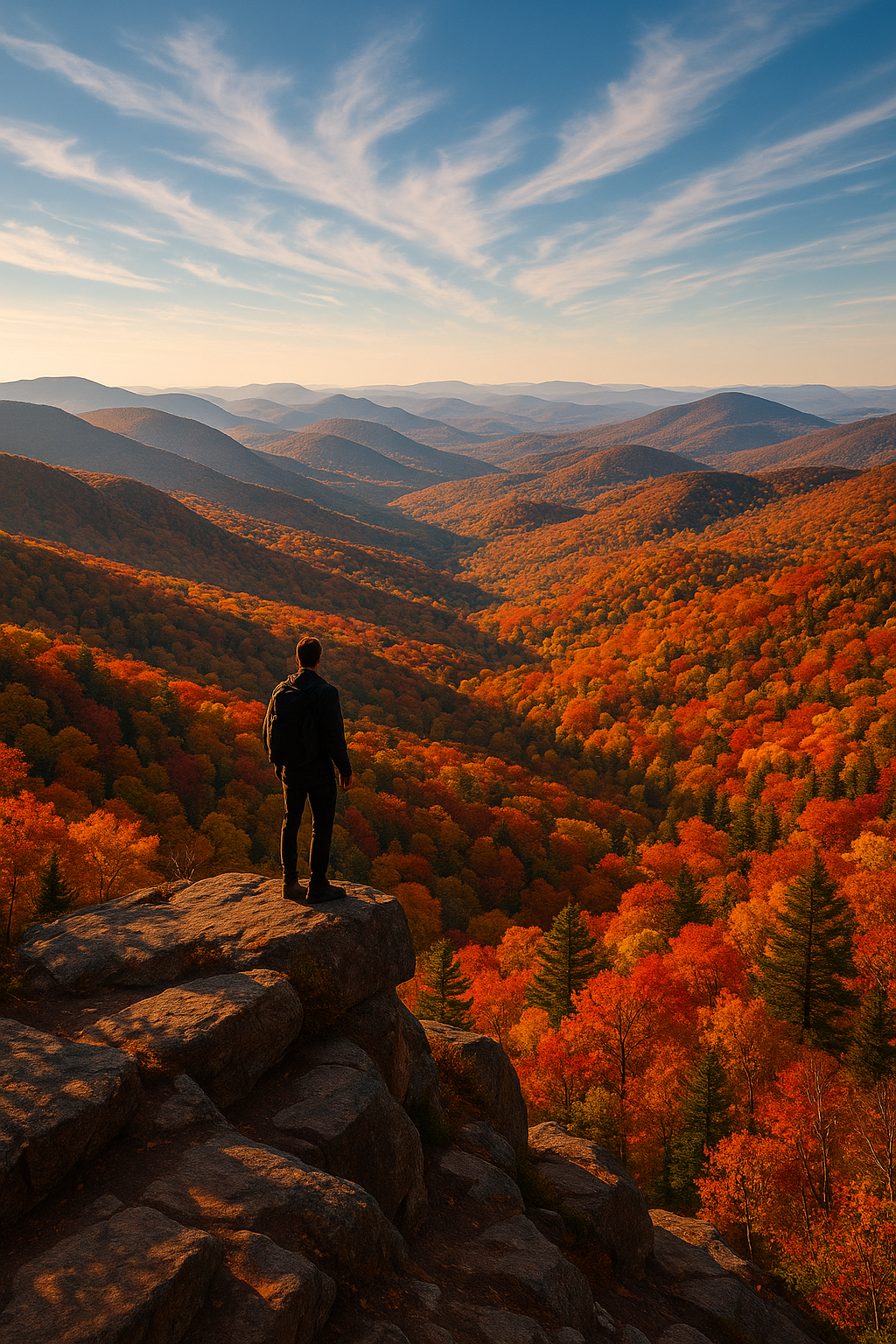
Best Time to Plan Your Fall Foliage Hiking Adventure {#timing-guide}
Timing represents the most critical factor in successful fall foliage hikes, as peak color windows vary dramatically by latitude, elevation, and local climate conditions. Understanding these patterns enables hikers to maximize their chances of experiencing nature’s most spectacular displays while avoiding the disappointment of arriving too early or too late for optimal viewing conditions.
The general rule for autumn hiking trails follows a predictable north-to-south and high-to-low elevation progression. Northern regions and higher elevations typically reach peak colors first, with the wave of autumn gradually moving southward at approximately 35 miles per day and downward in elevation at roughly 100 feet per day. This natural progression means that fall colors hiking enthusiasts can potentially follow the peak season across multiple regions by planning strategic multi-destination trips.
In New England, the epicenter of American fall foliage viewing, peak season typically begins in late September at elevations above 3,000 feet and progresses to lower elevations through mid-October. Vermont’s Green Mountains and New Hampshire’s White Mountains usually reach peak colors during the first week of October, while coastal Maine experiences optimal conditions during the second and third weeks of October. The best fall hiking destinations in this region often provide real-time foliage reports through state tourism departments and local visitor centers.
Mid-Atlantic regions experience peak seasonal hiking conditions approximately 1-2 weeks later than New England. Pennsylvania’s Pocono Mountains and New York’s Adirondacks typically reach peak colors during the second week of October, while Virginia’s Shenandoah National Park and the Blue Ridge Parkway achieve optimal viewing conditions from mid to late October. These autumn outdoor adventures benefit from extended seasons due to diverse elevation ranges that create staggered peak periods across different trail systems.
Western mountain regions follow different patterns due to distinct tree species and climate conditions. Colorado’s aspen groves, among the most photographed fall foliage hikes in America, typically peak during the last week of September through the first week of October at elevations between 8,000-10,000 feet. Washington State’s alpine larch displays occur even earlier, usually reaching peak golden colors during the third week of September at elevations above 5,000 feet.
Weather patterns significantly influence timing predictions, with early frost accelerating color development while warm, wet conditions can delay peak periods by up to two weeks. Successful fall colors hiking requires monitoring both long-range weather forecasts and real-time foliage reports from reliable sources including state park services, local hiking organizations, and specialized foliage tracking websites.
Essential Gear for Autumn Trail Adventures {#essential-gear}
Fall foliage hikes present unique gear requirements that differ significantly from summer hiking due to rapidly changing weather conditions, shorter daylight hours, and increased precipitation probability. Proper equipment selection can mean the difference between a memorable adventure and a miserable experience, making gear preparation crucial for successful autumn hiking trails exploration.
Layered clothing systems represent the foundation of effective fall hiking gear, as temperatures can fluctuate 30-40 degrees between early morning starts and midday hiking. A typical layering system should include moisture-wicking base layers, insulating mid-layers such as fleece or down jackets, and waterproof outer shells capable of handling sudden rain showers or snow flurries common during seasonal hiking periods. Quality waterproof hiking gear becomes essential as autumn weather patterns tend to be more unpredictable than summer conditions.
Footwear selection for fall colors hiking requires careful consideration of trail conditions that may include wet leaves, muddy sections, and early morning frost. Waterproof hiking boots with aggressive tread patterns provide necessary traction on slippery surfaces while maintaining foot warmth and dryness throughout extended hiking periods. Gaiters offer additional protection against debris and moisture, particularly valuable when hiking through areas with heavy leaf accumulation.
Navigation equipment gains increased importance during autumn outdoor adventures due to shorter daylight hours and potential visibility reduction from weather conditions. GPS devices, detailed topographic maps, and compass systems should be standard equipment, supplemented by headlamps with extra batteries for early morning starts or unexpected delays. Many best fall hiking destinations experience increased visitor traffic during peak season, making early starts essential for optimal photography opportunities and peaceful trail experiences.
Photography equipment represents a specialized gear category for fall foliage viewing enthusiasts. Polarizing filters help reduce glare and enhance color saturation, while tripods enable sharp images in lower light conditions common during autumn months. Extra batteries become crucial as cold temperatures significantly reduce battery life in electronic devices. Weather protection for cameras and lenses prevents damage from sudden precipitation that frequently occurs during fall foliage hikes.
Emergency preparedness takes on added significance during autumn hiking due to increased weather variability and shorter rescue windows before darkness. Essential safety items should include emergency shelters, first aid supplies, fire-starting materials, and emergency communication devices. The essential items for backpacking trips provide comprehensive guidance for safety equipment selection appropriate for extended autumn hiking trails adventures.

Top 12 Fall Foliage Hiking Destinations {#top-destinations}
The following destinations represent America’s premier fall foliage hikes, selected based on color intensity, trail diversity, accessibility, and overall hiking experience quality. Each location offers unique characteristics that showcase different aspects of autumn’s natural beauty while providing varying difficulty levels to accommodate all hiking abilities.
1. Mount Washington, New Hampshire – White Mountains
Mount Washington stands as the crown jewel of New England’s autumn hiking trails, offering the most diverse elevation-based foliage experience in the eastern United States. The mountain’s 6,288-foot summit provides access to multiple climate zones, creating a compressed version of the entire northeastern fall color progression within a single hiking experience. The Tuckerman Ravine Trail, spanning 4.2 miles to the summit, showcases this elevation diversity as hikers progress from mixed hardwood forests at the base through boreal spruce-fir forests near the summit.
Peak foliage timing on Mount Washington follows a predictable elevation pattern, with colors beginning at the summit in early September and progressing downward through late September and early October. The mountain’s weather station provides real-time conditions that help hikers plan optimal timing for fall colors hiking adventures. The combination of challenging terrain and spectacular views makes this one of the best fall hiking destinations for experienced hikers seeking both physical challenge and visual rewards.
Trail conditions during peak season require careful preparation due to rapidly changing weather conditions and increased visitor traffic. The mountain’s notorious weather patterns can shift from pleasant autumn conditions to winter-like storms within hours, making proper gear selection crucial for safe hiking experiences. Alternative routes including the Ammonoosuc Ravine Trail and Jewell Trail provide different perspectives on the mountain’s autumn transformation while offering varying difficulty levels for different hiking abilities.
2. Acadia National Park, Maine – Coastal Fall Colors
Acadia National Park offers a unique fall foliage viewing experience that combines spectacular autumn colors with dramatic coastal scenery unavailable anywhere else in America. The park’s 45 miles of carriage roads and 125 miles of hiking trails provide diverse options for experiencing Maine’s distinctive blend of maritime and forest environments during peak color season. The Great Head Trail, a 1.7-mile loop, exemplifies this unique combination by offering panoramic views of autumn-colored forests framing the rugged Atlantic coastline.
The park’s diverse ecosystems create extended peak viewing periods, with different areas reaching optimal colors at varying times throughout October. Cadillac Mountain, accessible via the 3.5-mile Cadillac Summit Loop Trail, provides the earliest sunrise views in the United States during autumn months, creating spectacular photography opportunities as morning light illuminates the surrounding fall foliage. The mountain’s 1,530-foot elevation offers panoramic views of the surrounding islands and mainland forests during their peak color transformation.
Coastal influences moderate temperature extremes, creating ideal hiking conditions throughout the fall season. The park’s location receives consistent moisture from Atlantic weather systems, maintaining vibrant colors longer than inland locations while providing comfortable hiking temperatures. The Jordan Pond Path, a 3.3-mile loop around the park’s most photographed lake, offers accessible autumn outdoor adventures suitable for families while showcasing the park’s signature combination of mountain and water views framed by spectacular fall colors.
3. Great Smoky Mountains National Park, Tennessee/North Carolina
The Great Smoky Mountains represent the most biodiverse fall foliage hikes destination in America, with over 100 tree species creating an unparalleled variety of autumn colors. The park’s 800 miles of trails traverse elevations from 875 to 6,643 feet, providing access to multiple forest types and extended peak viewing periods that span from late September through early November. The Cataract Falls Trail, a moderate 1-mile hike, showcases the park’s diverse hardwood forests while leading to a spectacular 25-foot waterfall surrounded by peak autumn colors.
The park’s unique geography creates microclimates that extend the seasonal hiking season significantly beyond other southeastern destinations. Higher elevations experience peak colors in early October, while lower elevation areas maintain vibrant displays through late October and early November. This elevation diversity allows visitors to experience multiple peak periods within a single visit by hiking trails at different elevations throughout their stay.
Wildlife viewing opportunities enhance the autumn hiking trails experience, as the park’s diverse animal populations become more active during cooler fall temperatures. Black bears, white-tailed deer, and over 200 bird species provide additional attractions beyond the spectacular foliage displays. The Alum Cave Trail, leading to Mount LeConte’s 6,593-foot summit, offers challenging hiking combined with some of the park’s most spectacular autumn vistas and unique geological features including natural rock arches and cliff-side views.
4. Shenandoah National Park, Virginia – Blue Ridge Mountains
Shenandoah National Park’s 105-mile Skyline Drive provides access to over 500 miles of hiking trails that showcase the Blue Ridge Mountains’ legendary autumn transformation. The park’s diverse elevation range from 540 to 4,051 feet creates staggered peak periods that extend optimal fall foliage viewing from early October through early November. Old Rag Mountain, accessed via a challenging 9.2-mile circuit trail, offers the park’s most spectacular 360-degree views of the surrounding Blue Ridge Mountains during peak color season.
The park’s strategic location along the Blue Ridge Parkway creates opportunities for extended fall colors hiking adventures that can span multiple states and weeks of peak viewing. The Dark Hollow Falls Trail, a moderate 1.4-mile round trip hike, leads to the park’s most accessible waterfall while traversing through diverse forest types that showcase the region’s spectacular autumn color palette. The trail’s relatively easy difficulty makes it ideal for families seeking autumn outdoor adventures without extreme physical demands.
Shenandoah’s extensive trail network includes options for all hiking abilities, from gentle nature walks to challenging backcountry expeditions. The Whiteoak Canyon Trail system offers multiple waterfall destinations with varying difficulty levels, allowing hikers to customize their experience based on available time and physical capabilities. The park’s well-maintained trail system and comprehensive visitor services make it one of the most accessible best fall hiking destinations for first-time autumn hiking enthusiasts.
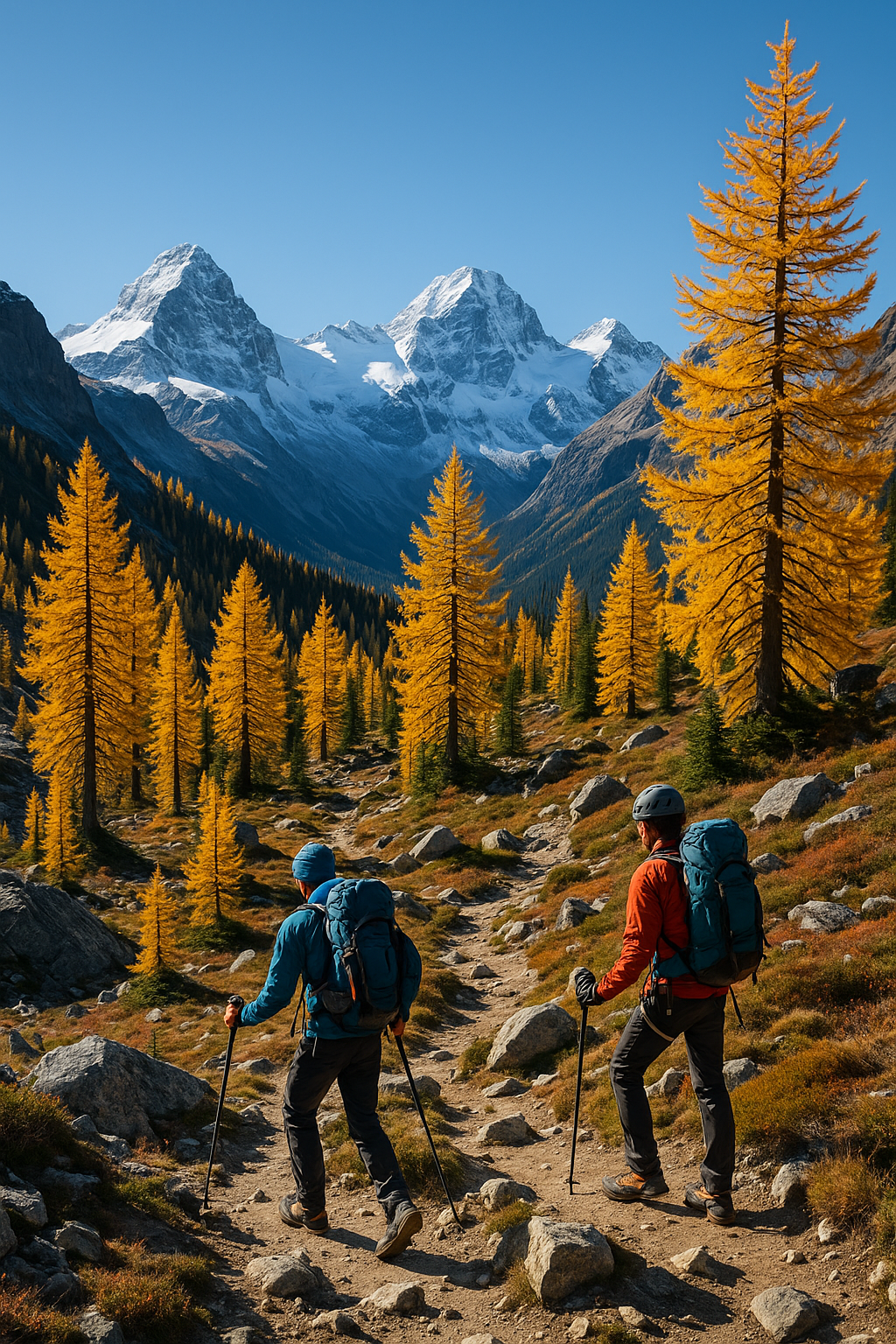
5. Green Mountains, Vermont – Classic New England Fall Colors
Vermont’s Green Mountains epitomize the classic New England fall foliage hikes experience, with sugar maples, red maples, and birch trees creating the iconic red, orange, and yellow displays featured in countless autumn photographs. Mount Mansfield, Vermont’s highest peak at 4,393 feet, offers multiple trail options including the challenging 5.2-mile Long Trail approach and the more moderate 3.4-mile Sunset Ridge Trail. Both routes provide spectacular views of the Champlain Valley and Adirondack Mountains framed by Vermont’s legendary autumn colors.
The state’s extensive trail network includes over 900 miles of hiking paths that traverse diverse forest types and elevation ranges. The Camel’s Hump Trail, a 5.4-mile round trip hike to Vermont’s third-highest peak, showcases the state’s diverse forest ecosystems while providing panoramic views of the surrounding Green Mountains during peak color season. The trail’s moderate difficulty and well-maintained condition make it accessible to intermediate hikers seeking authentic Vermont autumn hiking trails experiences.
Vermont’s commitment to forest conservation ensures sustainable access to seasonal hiking opportunities while maintaining the ecological integrity that creates spectacular autumn displays. The state’s maple syrup industry provides additional cultural context for fall visits, with many hiking destinations located near working sugar houses that offer educational opportunities about forest management and maple production. The Mount Equinox Skyline Drive provides vehicle access to high-elevation viewpoints for those seeking spectacular views without extensive hiking requirements.
6. Adirondack Park, New York – Wilderness Fall Colors
Adirondack Park’s 6 million acres represent the largest publicly protected area in the contiguous United States, providing access to pristine fall foliage viewing experiences in true wilderness settings. The park’s 3,000 lakes and ponds create unique reflection opportunities for autumn photography while its 30,000 miles of rivers and streams provide diverse aquatic environments that enhance the overall hiking experience. Mount Marcy, New York’s highest peak at 5,344 feet, offers challenging autumn outdoor adventures with spectacular views of the surrounding Adirondack wilderness during peak color season.
The park’s diverse elevation range from 95 to 5,344 feet creates extended peak viewing periods that span from mid-September through mid-October. The Cascade Mountain Trail, a moderate 4.8-mile round trip hike, provides accessible summit views while showcasing the park’s diverse forest types and spectacular autumn color displays. The trail’s popularity during peak season requires early morning starts to avoid crowds and secure optimal photography opportunities.
Adirondack Park’s wilderness character provides opportunities for multi-day fall colors hiking adventures that combine spectacular autumn scenery with true backcountry experiences. The High Peaks Wilderness area contains 46 peaks over 4,000 feet, creating numerous options for challenging hiking adventures during peak foliage season. The park’s extensive lean-to shelter system enables overnight hiking trips that maximize exposure to autumn’s fleeting beauty while providing authentic wilderness experiences unavailable in more developed hiking destinations.
7. Cascade Range, Washington – Alpine Larch Spectacle
Washington’s Cascade Range offers one of America’s most unique fall foliage hikes experiences through its alpine larch forests, which create brilliant golden displays at high elevations during late September and early October. Unlike other coniferous trees, alpine larches shed their needles annually, creating spectacular golden forests that contrast dramatically with surrounding evergreen forests and snow-capped peaks. The Blue Lake Trail in the North Cascades provides access to some of the state’s most spectacular alpine larch displays within a challenging 4.4-mile round trip hike.
The short peak season for alpine larch viewing, typically lasting only 2-3 weeks, creates urgency that enhances the seasonal hiking experience. Weather conditions at high elevations can change rapidly during autumn, requiring careful planning and appropriate gear for safe hiking experiences. The Maple Pass Loop Trail, an 7.2-mile circuit hike, combines alpine larch viewing with spectacular views of North Cascades peaks while providing access to diverse high-elevation ecosystems.
Washington’s diverse geography creates multiple autumn hiking trails opportunities beyond alpine larch viewing. The state’s lower elevation forests provide traditional fall color displays that peak during October, extending the overall autumn hiking season for visitors willing to explore different elevation zones. The Mount Rainier area offers spectacular autumn hiking with the added attraction of the mountain’s glaciated peak providing dramatic backdrops for fall color photography.
8. Rocky Mountain National Park, Colorado – Aspen Gold
Rocky Mountain National Park’s aspen groves create some of America’s most photographed fall foliage viewing experiences, with golden leaves that shimmer and dance in mountain breezes while creating natural cathedrals of light and color. The park’s elevation range from 7,500 to 14,259 feet provides access to diverse ecosystems and extended peak viewing periods that typically span from mid-September through early October. The Bear Lake Trail system offers multiple hiking options that showcase the park’s spectacular aspen displays while providing access to alpine lakes and mountain vistas.
The park’s high elevation creates unique hiking conditions that require careful preparation for rapidly changing weather and reduced oxygen levels. The Emerald Lake Trail, a moderate 3.2-mile round trip hike, provides accessible mountain lake destinations while traversing through spectacular aspen groves during peak color season. The trail’s popularity requires early morning starts to avoid crowds and secure optimal photography opportunities in the park’s most scenic locations.
Colorado’s aspen forests create unique acoustic experiences as the leaves rustle in mountain breezes, adding an auditory dimension to autumn outdoor adventures that distinguishes them from other fall hiking destinations. The park’s extensive trail network includes options for all hiking abilities, from gentle lakeside walks to challenging high-altitude peak ascents. The park’s well-developed visitor services and comprehensive trail information make it one of the most accessible best fall hiking destinations for visitors unfamiliar with high-altitude hiking requirements.
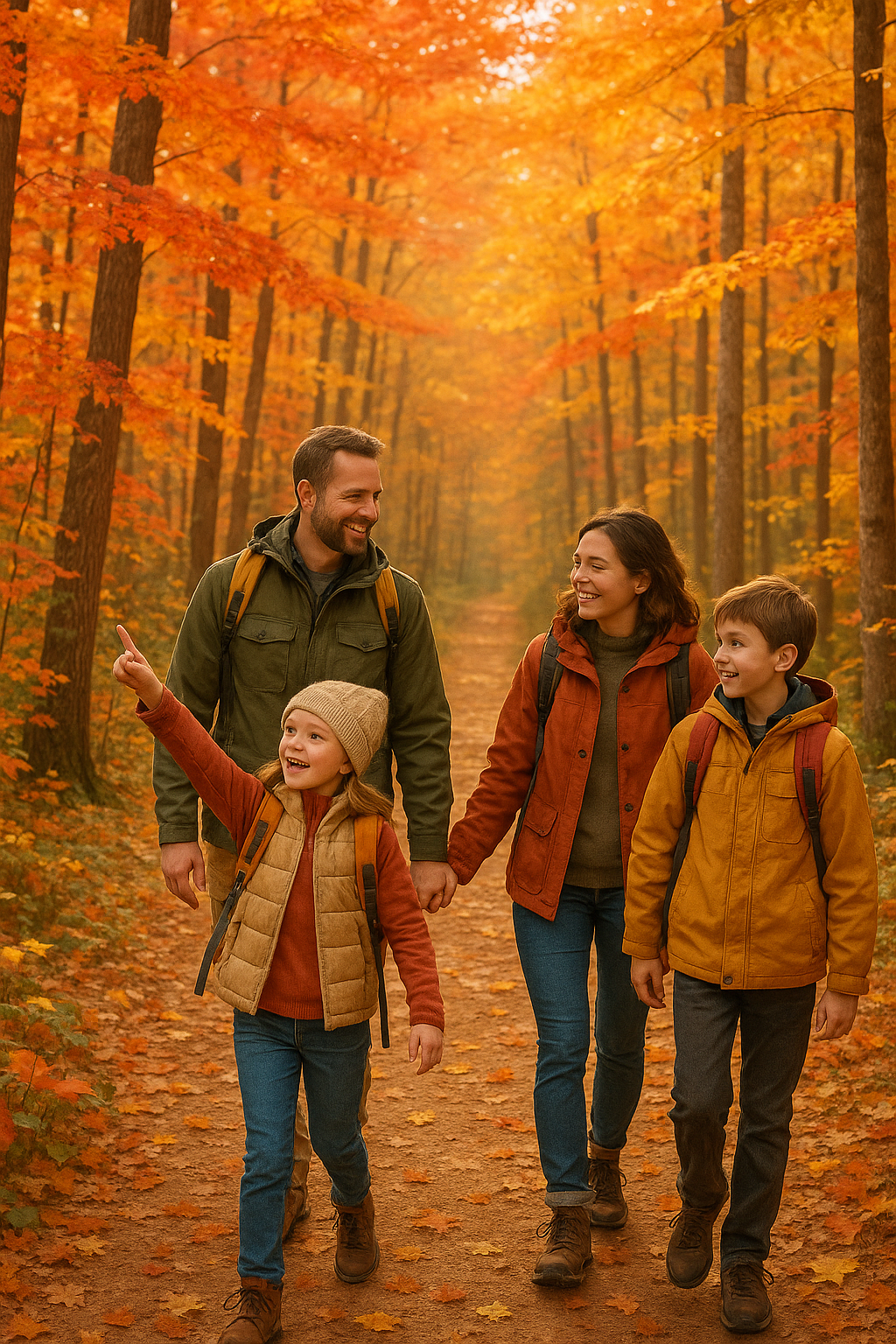
9. Upper Peninsula, Michigan – Hardwood Forest Diversity
Michigan’s Upper Peninsula offers spectacular fall colors hiking experiences through diverse hardwood forests that create some of the Midwest’s most vibrant autumn displays. The region’s numerous waterfalls provide unique opportunities to combine autumn foliage viewing with dramatic water features that enhance the overall hiking experience. Pictured Rocks National Lakeshore offers coastal hiking opportunities that combine fall colors with spectacular Lake Superior shoreline views, creating unique autumn hiking trails experiences unavailable elsewhere in the Great Lakes region.
The Upper Peninsula’s diverse forest composition includes sugar maples, red maples, yellow birch, and aspen trees that create complex color palettes ranging from deep reds to brilliant yellows. The Tahquamenon Falls Trail system provides access to Michigan’s largest waterfall while traversing through spectacular autumn forests during peak color season. The area’s relatively flat terrain makes it accessible to hikers of all abilities while still providing rewarding seasonal hiking experiences.
The region’s location along Lake Superior creates moderated climate conditions that extend peak viewing periods compared to inland locations at similar latitudes. The lake’s thermal mass delays frost formation while providing consistent moisture that maintains vibrant colors throughout the extended autumn season. The area’s numerous state parks and national forest lands provide diverse hiking opportunities that showcase different aspects of Upper Peninsula autumn beauty while offering varying difficulty levels and trail lengths.
10. Ozark Mountains, Arkansas – Southern Fall Colors
The Ozark Mountains provide unique fall foliage viewing opportunities in the southern United States, with diverse hardwood forests that create spectacular autumn displays during October and November. The region’s diverse tree species including hickories, oaks, maples, and dogwoods create complex color combinations that differ significantly from northern fall displays. Buffalo National River offers spectacular autumn outdoor adventures that combine fall colors with pristine river environments and diverse wildlife viewing opportunities.
The Ozarks’ diverse topography creates numerous hiking opportunities that showcase different aspects of southern autumn beauty. The Whitaker Point Trail, leading to the famous Hawksbill Crag overlook, provides spectacular views of the Buffalo River valley framed by autumn colors during peak season. The trail’s moderate 3-mile round trip distance makes it accessible to most hikers while providing rewarding views that justify the hiking effort required.
Arkansas’s extended growing season creates peak viewing periods that often extend into November, providing fall colors hiking opportunities when northern destinations have already lost their leaves. The state’s numerous state parks and national forest lands provide diverse trail options that accommodate all hiking abilities while showcasing the unique character of southern Appalachian autumn displays. The region’s mild climate during fall season creates ideal hiking conditions with comfortable temperatures and reduced precipitation compared to northern destinations.
11. Blue Ridge Parkway, Virginia/North Carolina – Scenic Drive with Hiking Access
The Blue Ridge Parkway’s 469-mile scenic route provides access to numerous best fall hiking destinations while offering spectacular driving experiences through some of America’s most beautiful autumn landscapes. The parkway’s numerous overlooks and trailheads create opportunities for customized hiking experiences that can range from short nature walks to challenging mountain ascents. Rough Ridge Trail, accessible from the parkway, offers spectacular views of the surrounding Blue Ridge Mountains while providing moderate hiking challenges suitable for intermediate hikers.
The parkway’s strategic routing along ridge lines provides consistent access to high-elevation viewpoints that showcase extensive autumn color displays across multiple mountain ranges. The Craggy Pinnacle Trail, a short 1.4-mile round trip hike, leads to spectacular 360-degree views of the surrounding mountains during peak color season. The trail’s accessibility and moderate difficulty make it ideal for families seeking autumn hiking trails experiences without extreme physical demands.
The Blue Ridge Parkway’s extensive visitor services and comprehensive trail information make it one of the most accessible seasonal hiking destinations for first-time autumn hiking enthusiasts. The parkway’s numerous campgrounds and lodging facilities enable extended visits that maximize exposure to peak color periods while providing comfortable base camps for daily hiking adventures. The route’s connection to multiple national parks and state parks creates opportunities for extended fall foliage hikes that can span multiple weeks and diverse geographic regions.
12. Finger Lakes Region, New York – Lakeside Fall Colors
New York’s Finger Lakes region offers unique fall foliage viewing experiences that combine spectacular autumn colors with pristine lake environments and diverse recreational opportunities. The region’s eleven glacial lakes create distinctive microclimates that moderate temperature extremes while providing spectacular reflection opportunities for autumn photography. Watkins Glen State Park offers spectacular hiking through a dramatic gorge system while showcasing the region’s diverse forest types during peak color season.
The region’s diverse topography creates numerous hiking opportunities that showcase different aspects of Finger Lakes autumn beauty. The Gorge Trail at Watkins Glen leads hikers through a spectacular stone gorge with 19 waterfalls while traversing through diverse forest environments that display spectacular autumn colors. The trail’s unique geological features combined with autumn foliage create autumn outdoor adventures that provide both natural beauty and educational opportunities about glacial geology.
The Finger Lakes region’s extensive trail network includes options for all hiking abilities, from gentle lakeside walks to challenging hill climbs that provide panoramic views of multiple lakes framed by autumn colors. The region’s numerous state parks provide diverse hiking opportunities while offering comprehensive visitor services that make the area accessible to hikers of all experience levels. The area’s proximity to major metropolitan areas makes it one of the most accessible fall colors hiking destinations for urban residents seeking autumn outdoor experiences.
Regional Fall Foliage Timing Guide {#regional-timing}
Understanding regional timing patterns enables fall foliage hikes enthusiasts to plan multi-destination trips that maximize exposure to peak color conditions across different geographic areas. The following timing guide provides general frameworks for planning autumn hiking trails adventures, though specific conditions vary annually based on weather patterns and local climate variations.
| Region | Peak Season Start | Peak Season End | Elevation Factor | Key Species |
| Northern New England | Late September | Mid-October | 100 ft/day progression | Sugar Maple, Red Maple, Birch |
| Southern New England | Early October | Late October | Coastal moderation | Oak, Maple, Hickory |
| Mid-Atlantic Mountains | Mid-October | Early November | Extended season | Mixed Hardwoods |
| Great Smoky Mountains | Late September | Early November | Elevation diversity | 100+ tree species |
| Colorado Rockies | Mid-September | Early October | High altitude timing | Aspen, Cottonwood |
| Pacific Northwest | Late September | Mid-October | Alpine species focus | Alpine Larch, Vine Maple |
| Upper Midwest | Late September | Mid-October | Lake effect moderation | Maple, Birch, Aspen |
| Ozark Mountains | Mid-October | Late November | Extended southern season | Oak, Hickory, Dogwood |
Weather patterns significantly influence these general timing guidelines, with early frost accelerating color development while warm, wet conditions can delay peak periods by up to two weeks. Successful fall colors hiking requires monitoring both long-range weather forecasts and real-time foliage reports from reliable sources including state park services, local hiking organizations, and specialized foliage tracking websites.
Elevation plays a crucial role in timing predictions, with colors typically beginning at higher elevations and progressing downward at approximately 100 feet per day. This pattern enables hikers to experience multiple peak periods within single destinations by exploring trails at different elevations throughout their visits. Seasonal hiking enthusiasts can extend their autumn experiences by following elevation progressions within individual mountain ranges or by planning trips that move from higher to lower elevation destinations over time.
Latitude effects create predictable north-to-south progression patterns, with peak colors moving southward at approximately 35 miles per day under normal weather conditions. This progression enables autumn outdoor adventures that span multiple states and weeks of peak viewing by following the color wave as it moves across the continent. Planning trips that begin in northern destinations and progress southward maximizes exposure to peak conditions while providing diverse hiking experiences across different ecosystems and geographic regions.
Photography Tips for Capturing Autumn Colors {#photography-tips}
Fall foliage viewing provides exceptional photography opportunities that require specific techniques and equipment to capture the full beauty of autumn’s spectacular displays. Understanding lighting conditions, composition principles, and technical camera settings enables hikers to document their autumn hiking trails experiences while creating lasting memories of nature’s fleeting beauty.
Golden hour lighting, occurring during the first and last hours of daylight, provides optimal conditions for autumn photography by enhancing color saturation and creating warm, even illumination that brings out the full spectrum of fall colors. Early morning photography offers additional advantages including reduced wind conditions that minimize leaf movement and fewer crowds at popular best fall hiking destinations. The combination of crisp morning air and optimal lighting creates ideal conditions for capturing sharp, vibrant images that showcase autumn’s natural beauty.
Polarizing filters represent essential equipment for fall colors hiking photography, reducing glare from wet leaves and enhancing color saturation while improving contrast between different colored elements. These filters prove particularly valuable when photographing autumn scenes that include water features, as they reduce surface reflections while enhancing the visibility of underwater elements and improving overall image clarity. Circular polarizing filters provide the most versatility for hiking photography while maintaining compatibility with modern camera autofocus systems.
Composition techniques specific to autumn photography include using leading lines created by trails, streams, or fallen logs to guide viewers’ eyes through the image while showcasing the depth and dimension of forest environments. The rule of thirds applies particularly well to autumn outdoor adventures photography, with horizon lines positioned along the lower third of the frame to emphasize dramatic sky conditions or along the upper third to highlight foreground details such as colorful forest floors covered with fallen leaves.

Macro photography opportunities abound during seasonal hiking adventures, with individual leaves, dewdrops, and forest floor details providing intimate perspectives on autumn’s transformation. Close-up photography requires different techniques than landscape photography, including careful attention to depth of field and focus stacking techniques that ensure sharp detail throughout the image. Macro lenses or close-up filters enable hikers to capture the intricate details of autumn leaves while showcasing the complex patterns and textures that create fall’s visual appeal.
Weather protection for camera equipment becomes crucial during fall foliage hikes due to increased precipitation probability and temperature fluctuations that can cause condensation problems. Waterproof camera bags, lens cloths, and silica gel packets help protect equipment while maintaining functionality in challenging conditions. Battery performance decreases significantly in cold temperatures, making spare batteries and external power sources essential for extended photography sessions during autumn hiking adventures.
Safety Considerations for Fall Hiking {#safety-considerations}
Fall foliage hikes present unique safety challenges that differ significantly from summer hiking due to changing weather conditions, reduced daylight hours, and trail conditions affected by fallen leaves and increased moisture. Understanding these risks and implementing appropriate safety measures ensures that autumn hiking trails adventures remain enjoyable while minimizing potential hazards that could compromise hiker safety.
Weather variability represents the primary safety concern during fall colors hiking adventures, as conditions can change rapidly from pleasant autumn weather to winter-like storms within hours. Temperature swings of 30-40 degrees between morning and afternoon are common during peak season, requiring layered clothing systems and emergency shelter capabilities. Hypothermia risks increase significantly during autumn hiking due to wet conditions combined with temperature drops that can occur suddenly when weather systems move through hiking areas.
Trail conditions during seasonal hiking periods require increased attention due to wet leaves that create slippery surfaces and reduced visibility of trail obstacles. Fallen leaves can obscure trail markers, rocks, roots, and holes that present tripping hazards for unwary hikers. Proper footwear with aggressive tread patterns becomes essential for maintaining traction on slippery surfaces, while trekking poles provide additional stability and confidence when navigating challenging terrain conditions.
Reduced daylight hours during autumn significantly impact hiking safety by limiting available time for completing planned routes and increasing the likelihood of hiking in low-light conditions. Daylight hours decrease by approximately 2-3 minutes per day during peak fall season, requiring careful planning to ensure adequate time for completing hikes before darkness. Emergency lighting equipment including headlamps and backup batteries becomes essential gear for all autumn outdoor adventures, regardless of planned return times.
Wildlife activity increases during autumn months as animals prepare for winter, creating additional safety considerations for best fall hiking destinations visitors. Black bear encounters become more likely as bears increase feeding activity before hibernation, requiring proper food storage and awareness of bear safety protocols. Hunting seasons coincide with peak foliage periods in many areas, making bright clothing and awareness of hunting regulations important safety considerations for autumn hikers.
Emergency preparedness takes on increased importance during fall foliage viewing adventures due to weather unpredictability and increased remoteness of many autumn hiking destinations. Essential safety equipment should include emergency shelters, first aid supplies, fire-starting materials, emergency communication devices, and extra food and water beyond normal hiking requirements. The comprehensive safety guide for backpacking trips provides detailed equipment recommendations appropriate for autumn hiking safety requirements.
Planning Your Multi-Destination Fall Foliage Road Trip {#trip-planning}
Multi-destination fall foliage hikes enable enthusiasts to experience diverse autumn environments while following peak color progressions across different geographic regions. Strategic trip planning maximizes exposure to optimal viewing conditions while providing varied hiking experiences that showcase the full spectrum of American autumn beauty. Successful multi-destination trips require careful timing coordination, flexible itineraries, and comprehensive preparation for diverse hiking conditions.
Route planning for autumn hiking trails road trips should follow natural color progression patterns, typically beginning in northern or high-elevation destinations and moving southward or to lower elevations as the season progresses. A classic New England foliage road trip might begin in northern Vermont or New Hampshire during late September, progress through central New England during early October, and conclude in southern New England or the Mid-Atlantic region during mid to late October. This progression maximizes exposure to peak conditions while providing diverse hiking experiences across different mountain ranges and forest types.
Accommodation planning requires early reservations due to high demand during peak fall colors hiking season, with many popular destinations booking solid months in advance. Alternative accommodation strategies include camping in state and national parks, staying in less popular nearby towns, or planning trips during weekdays when demand is reduced. Flexibility in accommodation choices enables access to seasonal hiking destinations that might otherwise be unavailable during peak weekend periods.
Real-time foliage monitoring becomes crucial for successful multi-destination trips, as peak timing can vary significantly from predicted schedules based on weather conditions. State tourism departments, national park services, and specialized foliage tracking websites provide current condition reports that enable trip adjustments to maximize peak viewing opportunities. Social media platforms and hiking forums provide additional real-time information from other hikers currently visiting autumn outdoor adventures destinations.
Equipment considerations for multi-destination trips must account for varying climate conditions and hiking requirements across different regions and elevations. Packing strategies should include gear appropriate for both warm, pleasant conditions and cold, wet weather that can occur during autumn travel. The comprehensive packing guide for day hikes provides essential equipment recommendations that apply to multi-destination autumn hiking adventures.
Budget planning for best fall hiking destinations road trips should account for increased accommodation costs during peak season, higher fuel costs due to increased driving distances, and potential equipment needs for diverse hiking conditions. Peak season pricing can increase accommodation costs by 200-300% compared to off-season rates, making budget planning crucial for successful trip execution. Alternative strategies include camping, staying in budget accommodations, or planning trips during shoulder seasons when costs are reduced but colors may still be spectacular.
Conclusion
Fall foliage hikes represent America’s premier autumn outdoor experience, combining the physical benefits of hiking with the visual spectacle of nature’s most dramatic seasonal transformation. From the coastal beauty of Maine’s Acadia National Park to the alpine splendor of Colorado’s aspen groves, each destination offers unique characteristics that showcase different aspects of autumn’s fleeting beauty. The twelve destinations featured in this guide provide diverse options for hikers of all abilities while ensuring access to spectacular autumn hiking trails experiences that create lasting memories.
The science behind fall color development, combined with strategic timing and proper preparation, enables hikers to maximize their chances of experiencing peak conditions while safely enjoying seasonal hiking adventures. Understanding regional timing patterns, weather influences, and elevation effects allows for strategic trip planning that can extend autumn hiking seasons across multiple destinations and geographic regions.
Whether seeking challenging mountain ascents or gentle family-friendly nature walks, America’s autumn outdoor adventures provide opportunities for everyone to experience the magic of fall foliage hiking. The combination of physical activity, natural beauty, and seasonal urgency creates unique outdoor experiences that distinguish fall colors hiking from other recreational activities while providing lasting benefits for both physical and mental wellness.
The investment in proper gear, careful planning, and safety preparation pays dividends in enhanced hiking experiences that showcase autumn’s spectacular but fleeting beauty. As climate patterns continue to evolve, the timing and intensity of fall color displays may shift, making current opportunities to experience these natural wonders even more precious for outdoor enthusiasts seeking authentic connections with nature’s seasonal rhythms.
For those inspired to explore these magnificent best fall hiking destinations, remember that peak conditions last only briefly, making timing and preparation crucial for successful autumn hiking adventures. The rewards of experiencing nature’s most spectacular seasonal display while engaging in healthy outdoor activity create memories that last far beyond the brief weeks when autumn’s colors paint America’s landscapes in their most brilliant hues.
For more hiking inspiration and gear recommendations, explore our comprehensive guides to Northeast hiking trails and essential hiking equipment. Don’t forget to check out our mental health benefits of outdoor activities to understand how autumn hiking contributes to overall wellness.
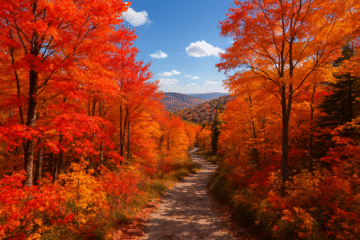


0 Comments